1998 NISSAN PICK-UP battery replacement
[x] Cancel search: battery replacementPage 1193 of 1659
![NISSAN PICK-UP 1998 Repair Manual If no self-diagnostic failure is detected on ``SELF-DIAG [CUR-
RENT] even though malfunction is detected in DIAGNOSTIC
PROCEDURE 1, check the battery voltage. If the battery voltage
is less than 9V, NISSAN PICK-UP 1998 Repair Manual If no self-diagnostic failure is detected on ``SELF-DIAG [CUR-
RENT] even though malfunction is detected in DIAGNOSTIC
PROCEDURE 1, check the battery voltage. If the battery voltage
is less than 9V,](/manual-img/5/57374/w960_57374-1192.png)
If no self-diagnostic failure is detected on ``SELF-DIAG [CUR-
RENT]'' even though malfunction is detected in DIAGNOSTIC
PROCEDURE 1, check the battery voltage. If the battery voltage
is less than 9V, charge the battery. Then go to DIAGNOSTIC
PROCEDURE 3, page RS-31. If the battery voltage is OK, go to
DIAGNOSTIC PROCEDURE 4, page RS-33, to diagnose the
following situations:
lDiagnosis results (previously stored in the memory) might not
be erased after repair.
lThe SRS system malfunctions intermittently.
8. Touch ``PRINT''.
9. Compare diagnostic codes to the CONSULT DIAGNOSTIC
CODE CHART, page RS-30.
10. Touch ``BACK'' key of CONSULT until SELECT SYSTEM
appears in order to return to User mode from Diagnosis
mode, then turn off CONSULT.
11. Turn ignition switch ``OFF'', then disconnect CONSULT and
both battery cables.
12. Repair the system as outlined by the ``Repair order'' in CON-
SULT DIAGNOSTIC CODE CHART, that corresponds to the
problem code. For replacement procedure of component
parts, refer to RS-10.
13. After repairing the system, go to DIAGNOSTIC PROCE-
DURE 3 for final checking, page RS-31.
CONSULT DIAGNOSTIC CODE CHART (``SELF-DIAG [CURRENT]'')
Diagnostic item Explanation/Possible causesRepair order
Recheck SRS at each replace-
ment.
NO SELF DIAGNOSTIC
FAILURE INDICATED.When malfunction is indi-
cated by the ``AIR BAG''
warning lamp in User
mode.
lSelf-diagnostic failure ``SELF-
DIAG [PAST]'' (previously stored
in the memory) might not be
erased after repair.
lIntermittent problem has been
detected in the past.
lGo to DIAGNOSTIC PROCE-
DURE 4 (RS-33).
lNo malfunction is detected.lGo to DIAGNOSTIC PROCE-
DURE 3 (RS-31).
AIRBAG MODULE
[OPEN]
lDriver's air bag module circuit is open. (including the spiral
cable)1. Visually check the wiring harness
connection.
2. Replace the harness if it has vis-
ible damage.
3. Replace driver's air bag module.
(Before disposal of it, it must be
deployed.)
4. Replace the spiral cable.
5. Replace the diagnosis sensor
unit. AIRBAG MODULE
[VB-SHORT]
lDriver's air bag module circuit is shorted to some power sup-
ply circuit. (including the spiral cable)
AIRBAG MODULE
[GND-SHORT]
lDriver's air bag module circuit is shorted to ground. (including
the spiral cable)
AIRBAG MODULE
[SHORT]
lDriver's air bag module circuits are shorted to each other.
CONTROL UNIT
lDiagnosis sensor unit is out of order. 1. Visually check the wiring harness
connections.
2. Replace the diagnosis sensor
unit.
* Follow the procedures in numerical order when repairing malfunctioning parts. Confirm whether malfunction is eliminated
using the air bag warning lamp or CONSULT each time repair is finished. If malfunction is still observed, proceed to the
next step. When malfunction is eliminated, further repair work is not required.
SRS049
TROUBLE DIAGNOSES Ð Supplemental Restraint System (SRS) Ð
4WD models
Trouble Diagnoses with CONSULT (Cont'd)
RS-30
Page 1198 of 1659
![NISSAN PICK-UP 1998 Repair Manual If no self-diagnostic failure is detected on ``SELF-DIAG [PAST],
touch ``BACK and go back to ``SELECT DIAG MODE.
8. Touch ``TROUBLE DIAG RECORD.
NOTE:
With TROUBLE DIAG RECORD, diagnosis resul NISSAN PICK-UP 1998 Repair Manual If no self-diagnostic failure is detected on ``SELF-DIAG [PAST],
touch ``BACK and go back to ``SELECT DIAG MODE.
8. Touch ``TROUBLE DIAG RECORD.
NOTE:
With TROUBLE DIAG RECORD, diagnosis resul](/manual-img/5/57374/w960_57374-1197.png)
If no self-diagnostic failure is detected on ``SELF-DIAG [PAST]'',
touch ``BACK'' and go back to ``SELECT DIAG MODE''.
8. Touch ``TROUBLE DIAG RECORD''.
NOTE:
With TROUBLE DIAG RECORD, diagnosis results previ-
ously erased by a reset operation can be displayed.
9. Diagnostic code is displayed on ``TROUBLE DIAG
RECORD''.
10. Touch ``PRINT''.
11. Compare diagnostic codes to the INTERMITTENT PROB-
LEM DIAGNOSTIC CODE CHART, page RS-36.
12. Touch ``BACK'' key of CONSULT until SELECT SYSTEM
appears, then turn off CONSULT.
13. Turn ignition switch ``OFF'', then disconnect CONSULT and
both battery cables.
14. Repair the system as outlined by the ``Repair order'' in
INTERMITTENT PROBLEM DIAGNOSTIC CODE CHART,
that corresponds to the problem code. For replacement pro-
cedure of component parts, refer to RS-10.
15. Go to DIAGNOSTIC PROCEDURE 3, page RS-31, for final
checking.
SRS062
SRS055
SRS315
TROUBLE DIAGNOSES Ð Supplemental Restraint System (SRS) Ð
4WD models
Trouble Diagnoses with CONSULT (Cont'd)
RS-35
Page 1200 of 1659
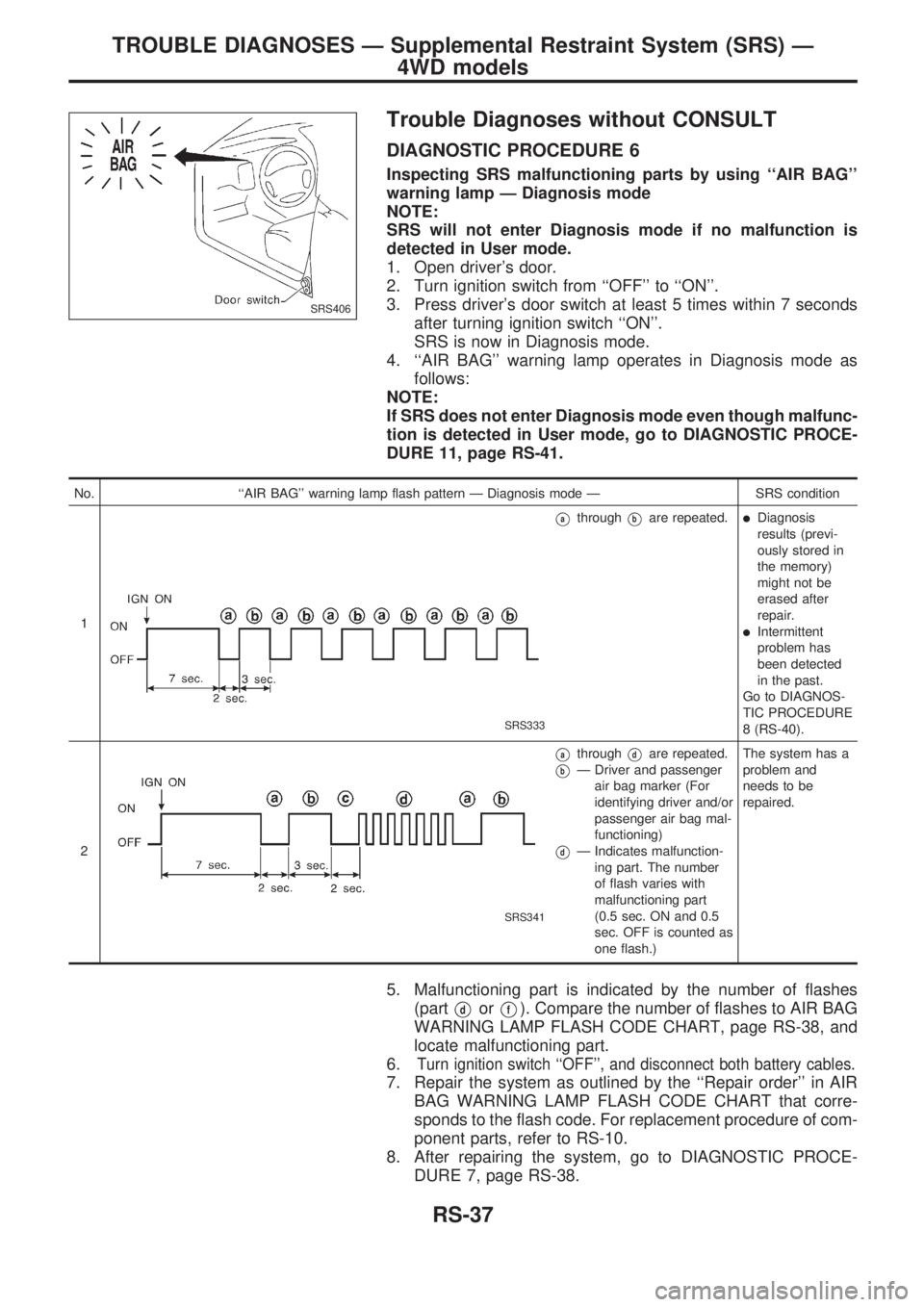
Trouble Diagnoses without CONSULT
DIAGNOSTIC PROCEDURE 6
Inspecting SRS malfunctioning parts by using ``AIR BAG''
warning lamp Ð Diagnosis mode
NOTE:
SRS will not enter Diagnosis mode if no malfunction is
detected in User mode.
1. Open driver's door.
2. Turn ignition switch from ``OFF'' to ``ON''.
3. Press driver's door switch at least 5 times within 7 seconds
after turning ignition switch ``ON''.
SRS is now in Diagnosis mode.
4. ``AIR BAG'' warning lamp operates in Diagnosis mode as
follows:
NOTE:
If SRS does not enter Diagnosis mode even though malfunc-
tion is detected in User mode, go to DIAGNOSTIC PROCE-
DURE 11, page RS-41.
No. ``AIR BAG'' warning lamp flash pattern Ð Diagnosis mode Ð SRS condition
1
SRS333
VathroughVbare repeated.lDiagnosis
results (previ-
ously stored in
the memory)
might not be
erased after
repair.
lIntermittent
problem has
been detected
in the past.
Go to DIAGNOS-
TIC PROCEDURE
8 (RS-40).
2
SRS341
VathroughVdare repeated.
VbÐ Driver and passenger
air bag marker (For
identifying driver and/or
passenger air bag mal-
functioning)
VdÐ Indicates malfunction-
ing part. The number
of flash varies with
malfunctioning part
(0.5 sec. ON and 0.5
sec. OFF is counted as
one flash.)The system has a
problem and
needs to be
repaired.
5. Malfunctioning part is indicated by the number of flashes
(part
VdorVf). Compare the number of flashes to AIR BAG
WARNING LAMP FLASH CODE CHART, page RS-38, and
locate malfunctioning part.
6.
Turn ignition switch ``OFF'', and disconnect both battery cables.
7. Repair the system as outlined by the ``Repair order'' in AIR
BAG WARNING LAMP FLASH CODE CHART that corre-
sponds to the flash code. For replacement procedure of com-
ponent parts, refer to RS-10.
8. After repairing the system, go to DIAGNOSTIC PROCE-
DURE 7, page RS-38.
SRS406
TROUBLE DIAGNOSES Ð Supplemental Restraint System (SRS) Ð
4WD models
RS-37
Page 1201 of 1659

AIR BAG WARNING LAMP FLASH CODE CHART (DIAGNOSIS MODE)
Warning
lampFlash codeVd(# of flashes)ExplanationRepair order
Recheck SRS at each replacement.
``AIR BAG'' warning lamp
0lSelf-diagnostic failure might not be erased after
repair.
lIntermittent problem has been detected in the
past.Go to DIAGNOSTIC PROCEDURE 8 (RS-40).
2 The driver's air bag module circuit is out of order. 1. Visually check the wiring harness connections.
2. Replace the spiral cable.
3. Replace the driver's air bag module.
(Before disposing of it, it must be deployed.)
4. Replace the diagnosis sensor unit.
5. Replace the air bag harness.
7 The diagnosis sensor unit is out of order. 1. Visually check the wiring harness connections.
2. Replace the diagnosis sensor unit.
* Follow the procedures in numerical order when repairing malfunctioning parts. Confirm whether malfunction is eliminated
using the air bag warning lamp (in User mode) or CONSULT each time repair is finished. If malfunction is still observed,
proceed to the next step. When malfunction is eliminated, further repair work is not required.
DIAGNOSTIC PROCEDURE 7
Final checking after repairing SRS by using ``AIR BAG''
warning lamp Ð Diagnosis mode and User mode
1. After repairing SRS connect both battery cables.
2. Open driver's door.
3. Turn ignition switch from ``OFF'' to ``ON''.
4. ``AIR BAG'' warning lamp operates in Diagnosis mode as
follows:
No. ``AIR BAG'' warning lamp flash pattern Ð Diagnosis mode Ð SRS condition
1
SRS333
VathroughVbare repeated. No malfunc-
tion is
detected or
repair is com-
pleted.
No further
action is nec-
essary.
2
SRS341
VathroughVdare repeated.
VbÐ Driver and passenger air
bag marker (For identifying
driver and/or passenger air
bag malfunctioning)
VdÐ Indicates malfunctioning
part. The number of
flashes varies with mal-
functioning part (0.5 sec.
ON and 0.5 sec. OFF is
counted as one flash.)The system
has a problem
and needs to
be repaired.
NOTE:
When diagnosis sensor unit is replaced with new one, ``AIR
BAG'' warning lamp will operate in User mode. Checking
``AIR BAG'' warning lamp operation in Diagnosis mode is
not required. Go to step 6.
SRS406
TROUBLE DIAGNOSES Ð Supplemental Restraint System (SRS) Ð
4WD models
Trouble Diagnoses without CONSULT
(Cont'd)
RS-38
Page 1296 of 1659
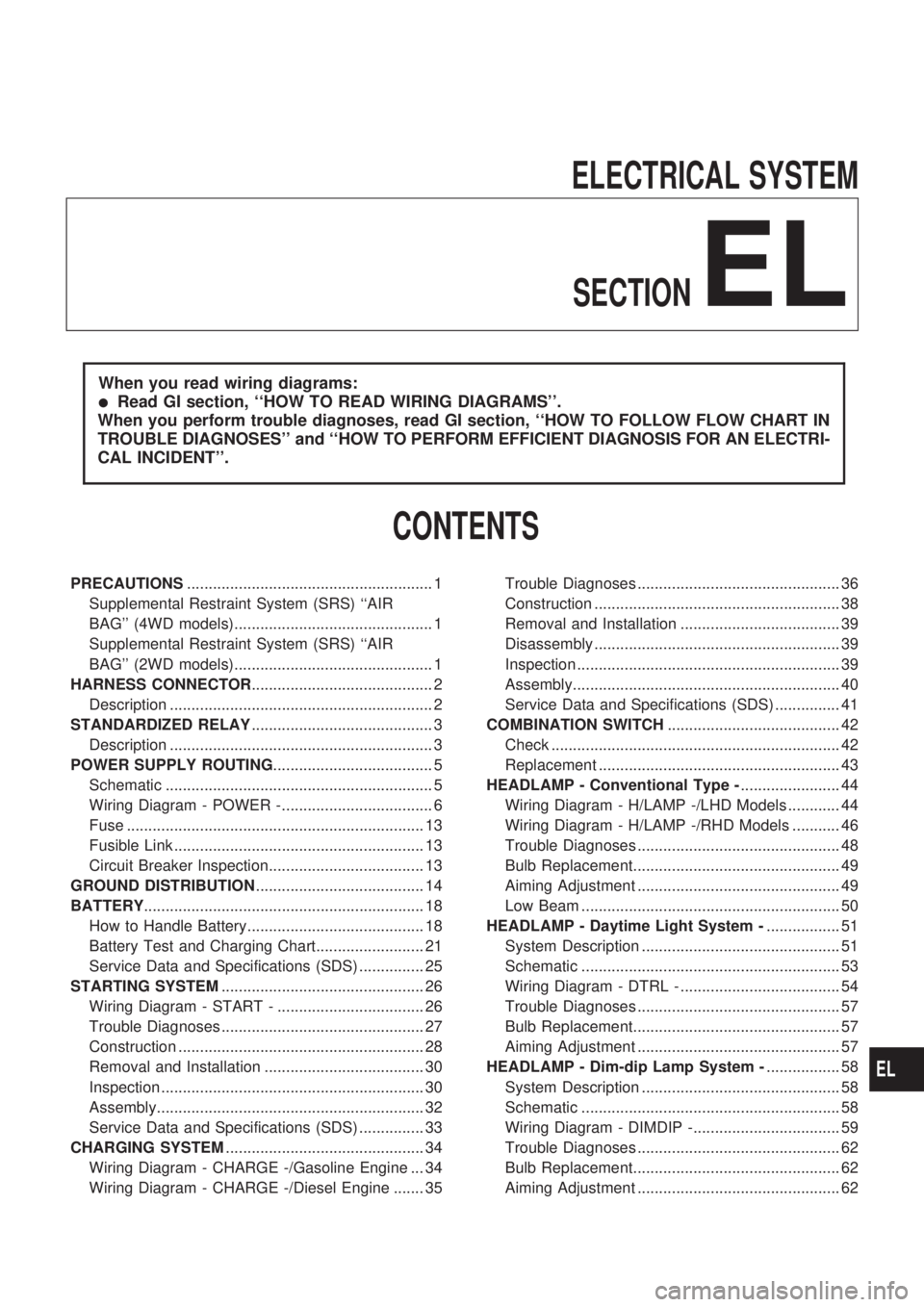
ELECTRICAL SYSTEM
SECTION
EL
When you read wiring diagrams:
lRead GI section, ``HOW TO READ WIRING DIAGRAMS''.
When you perform trouble diagnoses, read GI section, ``HOW TO FOLLOW FLOW CHART IN
TROUBLE DIAGNOSES'' and ``HOW TO PERFORM EFFICIENT DIAGNOSIS FOR AN ELECTRI-
CAL INCIDENT''.
CONTENTS
PRECAUTIONS......................................................... 1
Supplemental Restraint System (SRS) ``AIR
BAG'' (4WD models).............................................. 1
Supplemental Restraint System (SRS) ``AIR
BAG'' (2WD models).............................................. 1
HARNESS CONNECTOR.......................................... 2
Description ............................................................. 2
STANDARDIZED RELAY.......................................... 3
Description ............................................................. 3
POWER SUPPLY ROUTING..................................... 5
Schematic .............................................................. 5
Wiring Diagram - POWER -................................... 6
Fuse ..................................................................... 13
Fusible Link .......................................................... 13
Circuit Breaker Inspection.................................... 13
GROUND DISTRIBUTION....................................... 14
BATTERY................................................................. 18
How to Handle Battery......................................... 18
Battery Test and Charging Chart......................... 21
Service Data and Specifications (SDS) ............... 25
STARTING SYSTEM............................................... 26
Wiring Diagram - START - .................................. 26
Trouble Diagnoses ............................................... 27
Construction ......................................................... 28
Removal and Installation ..................................... 30
Inspection ............................................................. 30
Assembly.............................................................. 32
Service Data and Specifications (SDS) ............... 33
CHARGING SYSTEM.............................................. 34
Wiring Diagram - CHARGE -/Gasoline Engine ... 34
Wiring Diagram - CHARGE -/Diesel Engine ....... 35Trouble Diagnoses ............................................... 36
Construction ......................................................... 38
Removal and Installation ..................................... 39
Disassembly ......................................................... 39
Inspection ............................................................. 39
Assembly.............................................................. 40
Service Data and Specifications (SDS) ............... 41
COMBINATION SWITCH........................................ 42
Check ................................................................... 42
Replacement ........................................................ 43
HEADLAMP - Conventional Type -....................... 44
Wiring Diagram - H/LAMP -/LHD Models ............ 44
Wiring Diagram - H/LAMP -/RHD Models ........... 46
Trouble Diagnoses ............................................... 48
Bulb Replacement................................................ 49
Aiming Adjustment ............................................... 49
Low Beam ............................................................ 50
HEADLAMP - Daytime Light System -................. 51
System Description .............................................. 51
Schematic ............................................................ 53
Wiring Diagram - DTRL - ..................................... 54
Trouble Diagnoses ............................................... 57
Bulb Replacement................................................ 57
Aiming Adjustment ............................................... 57
HEADLAMP - Dim-dip Lamp System -................. 58
System Description .............................................. 58
Schematic ............................................................ 58
Wiring Diagram - DIMDIP -.................................. 59
Trouble Diagnoses ............................................... 62
Bulb Replacement................................................ 62
Aiming Adjustment ............................................... 62
EL
Page 1347 of 1659
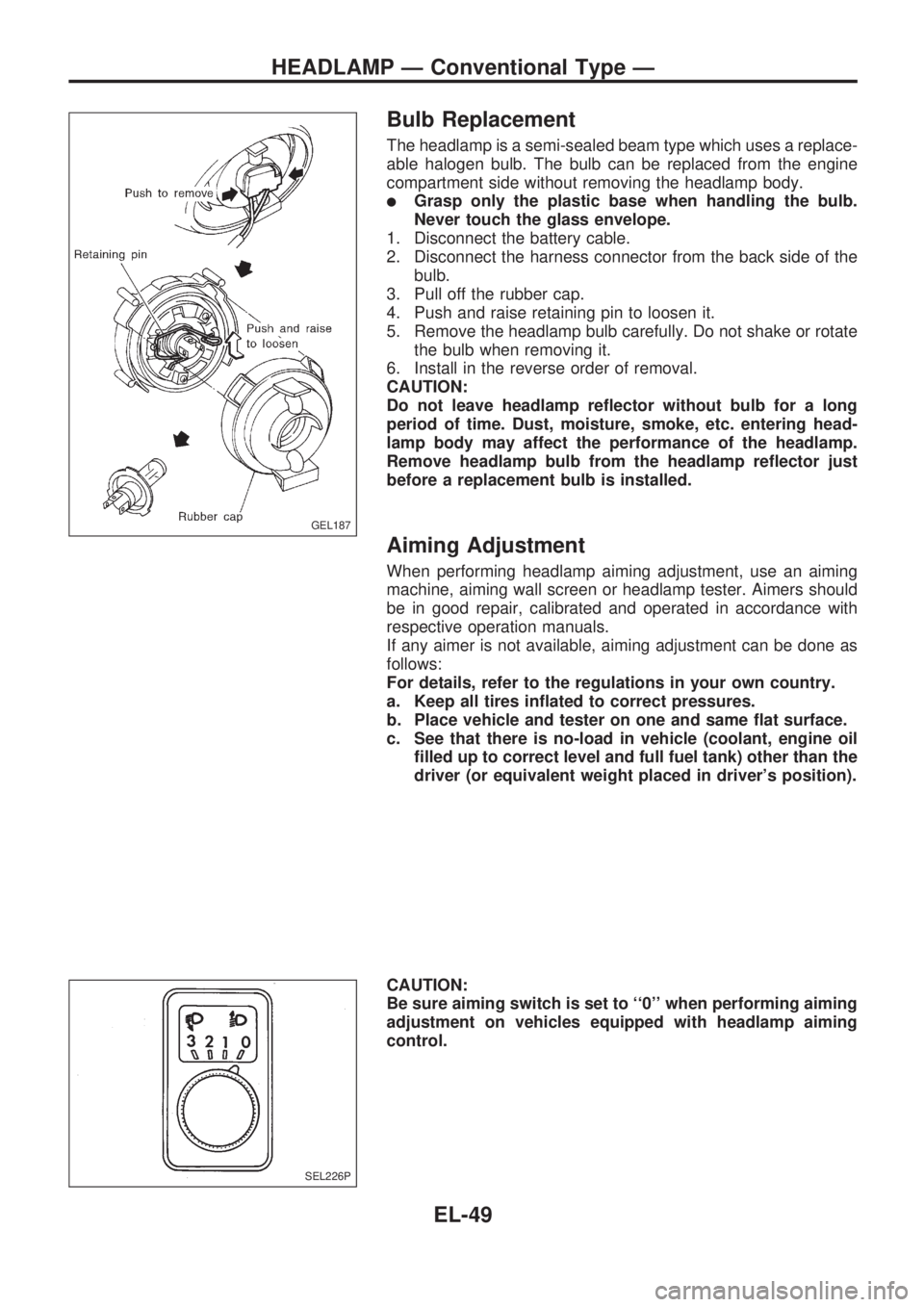
Bulb Replacement
The headlamp is a semi-sealed beam type which uses a replace-
able halogen bulb. The bulb can be replaced from the engine
compartment side without removing the headlamp body.
lGrasp only the plastic base when handling the bulb.
Never touch the glass envelope.
1. Disconnect the battery cable.
2. Disconnect the harness connector from the back side of the
bulb.
3. Pull off the rubber cap.
4. Push and raise retaining pin to loosen it.
5. Remove the headlamp bulb carefully. Do not shake or rotate
the bulb when removing it.
6. Install in the reverse order of removal.
CAUTION:
Do not leave headlamp reflector without bulb for a long
period of time. Dust, moisture, smoke, etc. entering head-
lamp body may affect the performance of the headlamp.
Remove headlamp bulb from the headlamp reflector just
before a replacement bulb is installed.
Aiming Adjustment
When performing headlamp aiming adjustment, use an aiming
machine, aiming wall screen or headlamp tester. Aimers should
be in good repair, calibrated and operated in accordance with
respective operation manuals.
If any aimer is not available, aiming adjustment can be done as
follows:
For details, refer to the regulations in your own country.
a. Keep all tires inflated to correct pressures.
b. Place vehicle and tester on one and same flat surface.
c. See that there is no-load in vehicle (coolant, engine oil
filled up to correct level and full fuel tank) other than the
driver (or equivalent weight placed in driver's position).
CAUTION:
Be sure aiming switch is set to ``0'' when performing aiming
adjustment on vehicles equipped with headlamp aiming
control.
GEL187
SEL226P
HEADLAMP Ð Conventional Type Ð
EL-49
Page 1442 of 1659
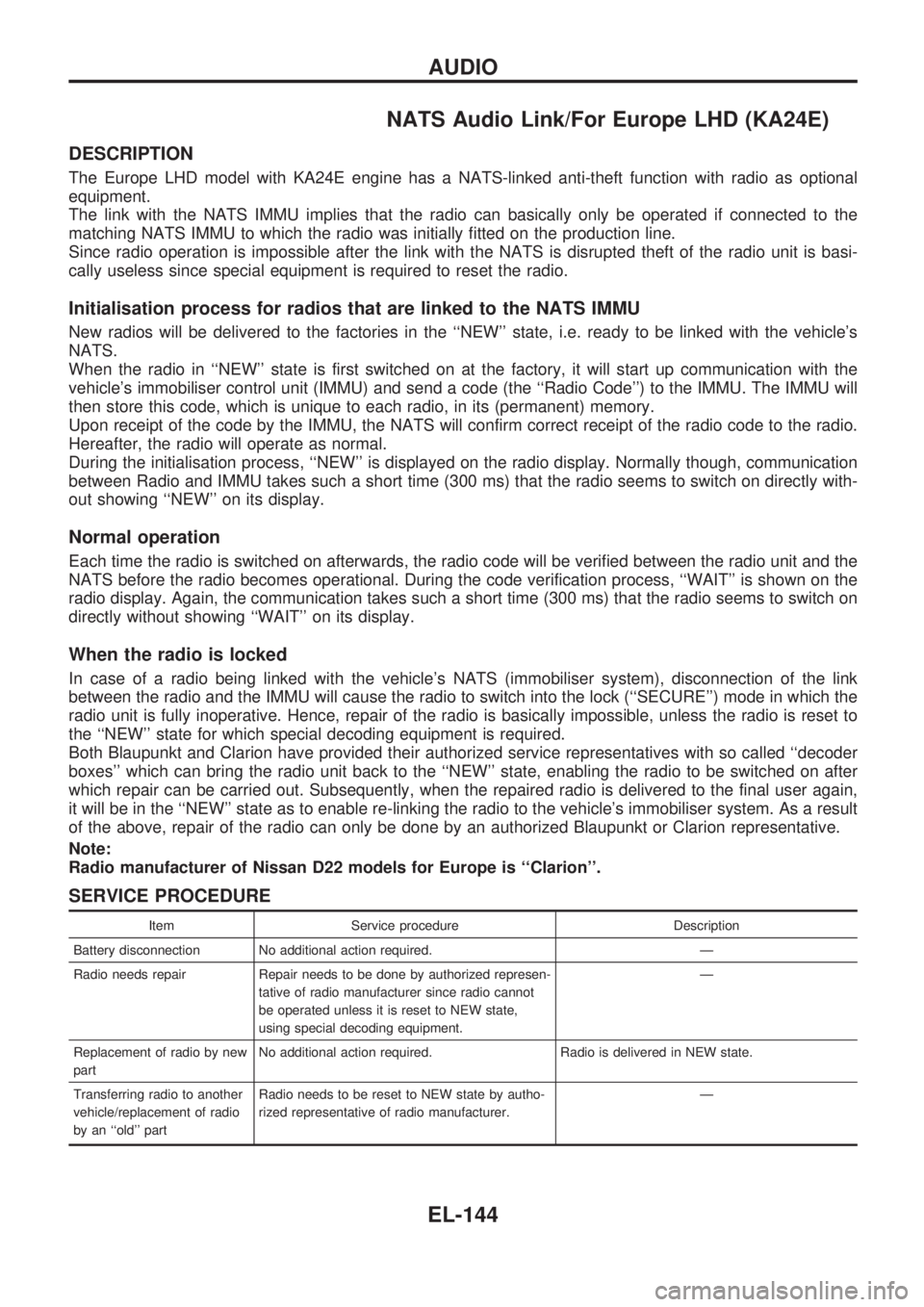
NATS Audio Link/For Europe LHD (KA24E)
DESCRIPTION
The Europe LHD model with KA24E engine has a NATS-linked anti-theft function with radio as optional
equipment.
The link with the NATS IMMU implies that the radio can basically only be operated if connected to the
matching NATS IMMU to which the radio was initially fitted on the production line.
Since radio operation is impossible after the link with the NATS is disrupted theft of the radio unit is basi-
cally useless since special equipment is required to reset the radio.
Initialisation process for radios that are linked to the NATS IMMU
New radios will be delivered to the factories in the ``NEW'' state, i.e. ready to be linked with the vehicle's
NATS.
When the radio in ``NEW'' state is first switched on at the factory, it will start up communication with the
vehicle's immobiliser control unit (IMMU) and send a code (the ``Radio Code'') to the IMMU. The IMMU will
then store this code, which is unique to each radio, in its (permanent) memory.
Upon receipt of the code by the IMMU, the NATS will confirm correct receipt of the radio code to the radio.
Hereafter, the radio will operate as normal.
During the initialisation process, ``NEW'' is displayed on the radio display. Normally though, communication
between Radio and IMMU takes such a short time (300 ms) that the radio seems to switch on directly with-
out showing ``NEW'' on its display.
Normal operation
Each time the radio is switched on afterwards, the radio code will be verified between the radio unit and the
NATS before the radio becomes operational. During the code verification process, ``WAIT'' is shown on the
radio display. Again, the communication takes such a short time (300 ms) that the radio seems to switch on
directly without showing ``WAIT'' on its display.
When the radio is locked
In case of a radio being linked with the vehicle's NATS (immobiliser system), disconnection of the link
between the radio and the IMMU will cause the radio to switch into the lock (``SECURE'') mode in which the
radio unit is fully inoperative. Hence, repair of the radio is basically impossible, unless the radio is reset to
the ``NEW'' state for which special decoding equipment is required.
Both Blaupunkt and Clarion have provided their authorized service representatives with so called ``decoder
boxes'' which can bring the radio unit back to the ``NEW'' state, enabling the radio to be switched on after
which repair can be carried out. Subsequently, when the repaired radio is delivered to the final user again,
it will be in the ``NEW'' state as to enable re-linking the radio to the vehicle's immobiliser system. As a result
of the above, repair of the radio can only be done by an authorized Blaupunkt or Clarion representative.
Note:
Radio manufacturer of Nissan D22 models for Europe is ``Clarion''.
SERVICE PROCEDURE
Item Service procedure Description
Battery disconnection No additional action required. Ð
Radio needs repair Repair needs to be done by authorized represen-
tative of radio manufacturer since radio cannot
be operated unless it is reset to NEW state,
using special decoding equipment.Ð
Replacement of radio by new
partNo additional action required. Radio is delivered in NEW state.
Transferring radio to another
vehicle/replacement of radio
by an ``old'' partRadio needs to be reset to NEW state by autho-
rized representative of radio manufacturer.Ð
AUDIO
EL-144
Page 1446 of 1659
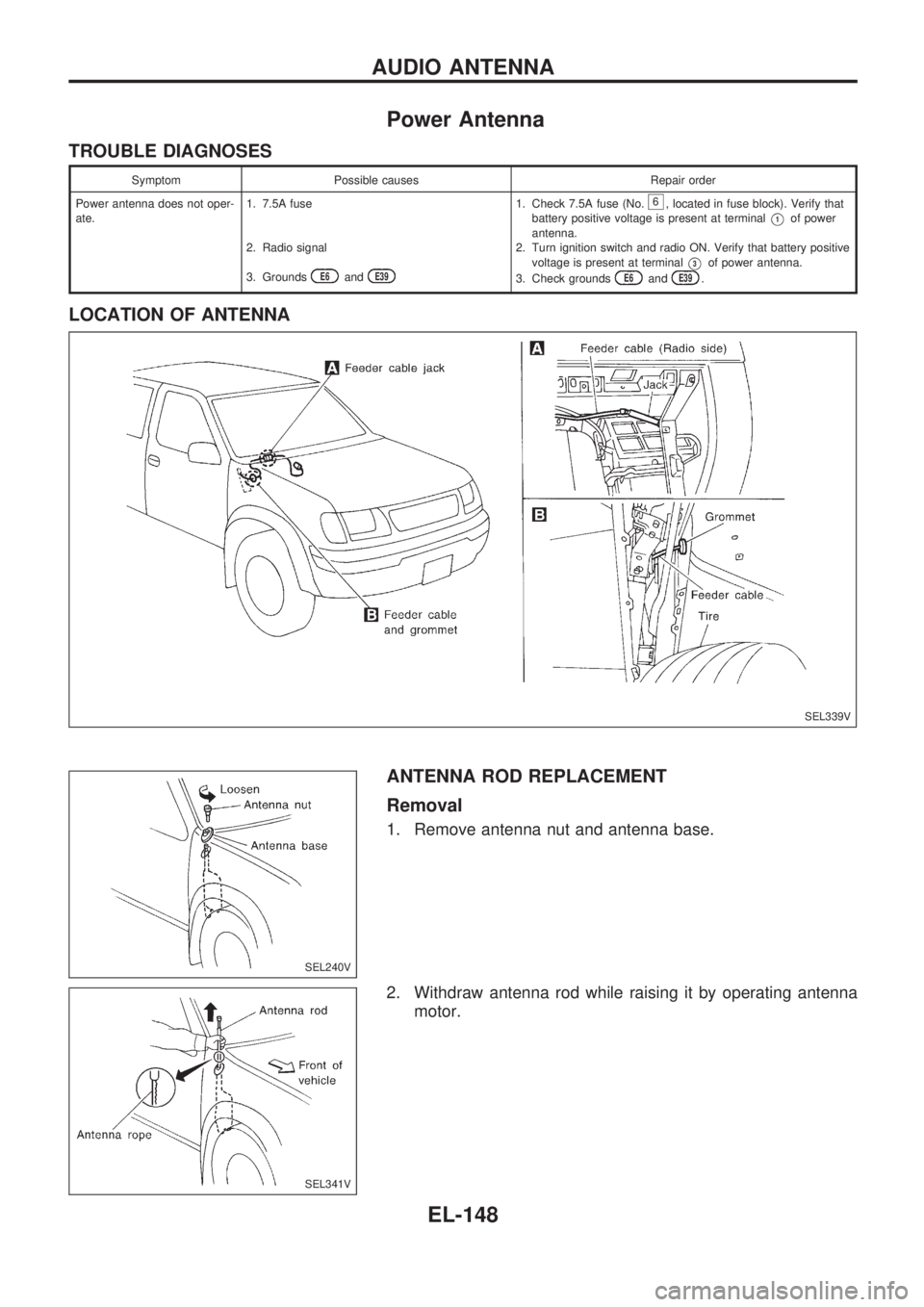
Power Antenna
TROUBLE DIAGNOSES
Symptom Possible causes Repair order
Power antenna does not oper-
ate.1. 7.5A fuse
2. Radio signal
3. Grounds
E6andE39
1. Check 7.5A fuse (No.6, located in fuse block). Verify that
battery positive voltage is present at terminal
V1of power
antenna.
2. Turn ignition switch and radio ON. Verify that battery positive
voltage is present at terminal
V3of power antenna.
3. Check groundsE6andE39.
LOCATION OF ANTENNA
ANTENNA ROD REPLACEMENT
Removal
1. Remove antenna nut and antenna base.
2. Withdraw antenna rod while raising it by operating antenna
motor.
SEL339V
SEL240V
SEL341V
AUDIO ANTENNA
EL-148